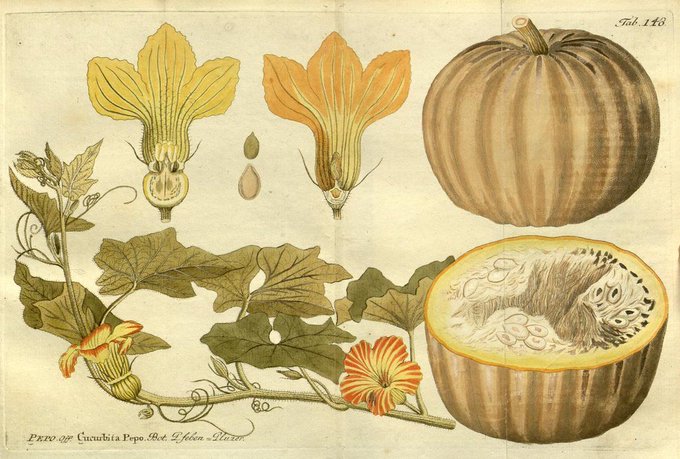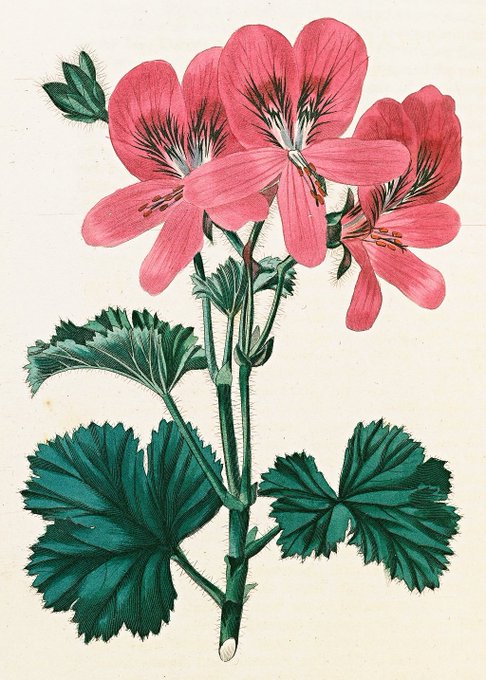BHLibのTwitterイラスト検索結果。 357 件中 4ページ目
Boas and Paulli’s “The Elephant’s Head" is a beautifully illustrated work dedicated to the craniofacial anatomy of the elephant, presented alongside several other mammals for comparison. Explore v.1 (1908) in #BHLib via @SILibraries ➡️ https://t.co/wDTehhQ51y #MammalMonday 🐘
#FloraFriday: Hybrid lilies, a cross between Lilium speciosum and Lilium auratum, cultivated by Mr. G. Thomson. #SciArt by Walter Hood Fitch for "The Florist and Pomologist" (1878), edited by Thomas Moore. Digitized in #BHLib by the @USDA_ARS ➡️ https://t.co/hHZ4v0yAZU
#Beetles are part of the taxonomic order #Coleoptera, which means "sheathed wing." #SciArt by Robert Morgan from "The Coleoptera of the British Islands", Vol. 3 (1889) by William W. Fowler. Contributed in #BHLib by @mayrlibrary of the @MCZHarvard ➡️ https://t.co/bLWSNYbBm3 🐞
The first illustrated book published in Australia was about birds! John Lewin's "The Birds of New South Wales" (1813) was republished in a 3rd and 4th edition, which are in #BHLib thanks to @museumsvictoria @bhl_au ➡️ https://t.co/eIWhc87vzS #Feathursday
Members of the genus Erica are known by the common names of heath and heather. "Coloured Engravings of Heaths" (1794-1830), by Henry Charles Andrews, was produced amidst England's "Erica-mania". Explore the 4 volumes in #BHLib via @NYBG @mobotgarden ➡️ https://t.co/PbKl8t2WKh
Three generations of Sowerbys contributed to "Thesaurus conchyliorum" (1847-87), one of the rarest of all conchology books. It includes over 500 hand-colored engraved or lithographed plates. Find it in #BHLib via @SILibraries ➡️ https://t.co/0j9WH3CQff #MolluskMonday 🐚
Carving a pumpkin this Halloween? #DYK that the pumpkin is a cultivar of a squash plant, most commonly of Cucurbita pepo? #SciArt from "Icones Plantarum Medico-Oeconomico-Technologicarum" (1800-22), in #BHLib via @mobotgarden ➡️ https://t.co/7Vpi1cAzRs #Halloween 🎃
Thanks to @museumsvictoria @bhl_au, we now have a color copy of Krefft's "Snakes of Australia" (1869) in #BHLib! The #SciArt is by Harriet Scott Morgan and Helena Scott Forde, who illustrated many works on Australian biodiversity. https://t.co/ztc8DRMS2r #HerNaturalHistory
J.D. Hooker's "Flora Antarctica", with #SciArt by Walter H. Fitch, describes specimens from the Ross expedition (1839–1843), which visited islands off the Antarctic continent's coast. Find it in #BHLib via @HarvardLibrary @MBLWHOILibrary @mobotgarden ➡️ https://t.co/p9fj9kTDZ3
Margaret Lace Roscoe hoped her "Floral Illustrations of the Seasons" (1831) would be a useful guide for other women "both in their selection for a flower garden, and as objects for their pencil." Explore the work in #BHLib via @NYBG ➡️ https://t.co/DJWFnSFCGY #HerNaturalHistory
Pierre Bulliard's "Herbier de la France" (1780-93) organized French plants & fungi according to their medicinal, poisonous, and edible qualities. The #SciArt was engraved and color-printed by the author. Explore it in #BHLib via @NYBG ➡️ https://t.co/gOzsNbNlky #FloraFriday
Entomologist Adolfo P. Mabilde lamented the lack of a published book on the insects of the Rio Grande. So he decided to publish one himself. Explore "Guia practica para os principiantes colleccionadores de Insectos" (1896) in #BHLib via @NHM_Library ➡️ https://t.co/bcoRRSRmlQ
The genus Zeledonia, containing the single species Zeledonia coronata, was named in honor of Costa Rican ornithologist José Castulo Zeledón. #SciArt by Henrik Grönvold from the "Ibis" (ser. 8, vol. 5, 1905), in #BHLib via @AMNH ➡️ https://t.co/twwYk9zBZx #HispanicHeritageMonth
German entomologist Carl Gustav Calwer specialized in Coleoptera. His popular beetle book was produced as a useful handbook on the natural history of European beetles. Explore Calwer's "Käferbuch" (1883) in #BHLib thanks to @Mann_Library ➡️ https://t.co/GTqETF5ml2 🐞
For your Monday morning viewing pleasure, we give you the brain of a kangaroo (from George Robert Waterhouse's 1846 "A Natural History of the Mammalia", new to #BHLib this week via @museumsvictoria @atlaslivingaust): https://t.co/XpaCzunxqp @biodivlibrary #MammalMonday
Townend Glover was described as one of the "finest illustrators" of insects in the United States. His two volume manuscript with notes and watercolors describes the life cycle of Lepidoptera. Explore it in #BHLib thanks to @USDA_ARS ➡️ https://t.co/FjBb6TX9pB #loveinsects
"Atlas sistemático de historia natural" (1867) — with 36 plates representing the animal, plant & mineral kingdoms — was intended as a teaching aid for schools & families. Explore the Atlas in #BHLib thanks to @institutomora as part of BHL México ➡️ https://t.co/CsyicEWJD0
Pheasant's Foot Geranium (Pelargonium glutinosum). #SciArt engraved by S. Watts after designs by Edwin Dalton Smith and published within Robert Sweet's 5-volume work on the family Geraniaceae, freely available in #BHLib via @NYBG ➡️ https://t.co/x98el8OAXD #BotanicMonday
Beautiful #shells from "D'Amboinsche Rariteitkamer" for #MolluskMonday! This 1705 work by Rumpf details the marine life of Amboina (Ambon) in what is now eastern Indonesia & features #SciArt by Maria Sybilla Merian. In #BHLib via @museumsvictoria @bhl_au: https://t.co/iB5ie7ZIIv
October is #BatAppreciationMonth! Bats are important pollinators and they also help keep insect populations (such as mosquitoes) in check. #SciArt by Ernst Haeckel from "Kunstformen der Natur" (1899-1904), in #BHLib via @SILibraries ➡️ https://t.co/2lKFtlcmGu #BatMonth 🦇🦇🦇






















































